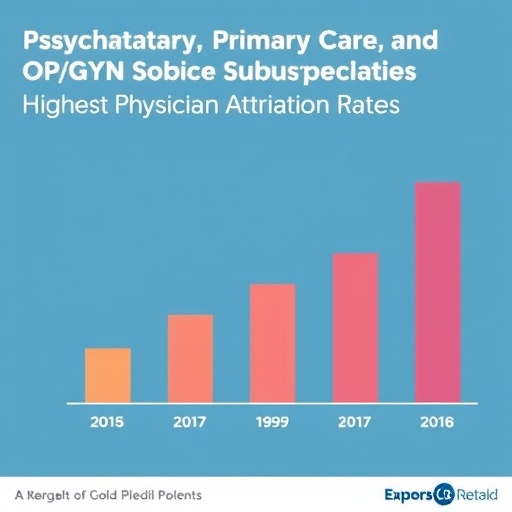A groundbreaking nationwide analysis has revealed alarming trends in physician attrition across various medical specialties, underscoring an intensifying crisis in the healthcare workforce. The longitudinal study, spanning from 2013 to 2019 and involving over 700,000 physicians treating Medicare beneficiaries, sheds light on how increasing attrition rates may exacerbate an existing shortage of clinical practitioners. This trend poses significant challenges for healthcare delivery systems already grappling with unprecedented demands.
The investigation meticulously examined physician exit patterns from active clinical practice, defining attrition as a permanent departure extending for at least three years without reentry. During the study period, the overall attrition rate surged from 3.5% to 4.9%, a notable escalation with wide-ranging implications. This sharp increase was pervasive across gender lines, geographic settings—urban and rural alike—and all examined medical specialties. Such a pervasive rise indicates systemic factors driving physicians away from their clinical roles, threatening to destabilize healthcare accessibility nationwide.
Particularly striking was the uneven distribution of attrition risk among different specialties. Psychiatry, primary care, and obstetrics and gynecology experienced significantly higher attrition rates compared to hospital-based specialties. These fields are traditionally frontline providers, crucial to preventive care, mental health, and maternal well-being. The loss of practitioners from these domains signals an ominous forecast for patient outcomes and continuity of care, highlighting an urgent need for targeted retention strategies.
Demographic and geographic disparities further complicated the attrition landscape. Female physicians exhibited a greater propensity to leave active practice, an outcome potentially influenced by factors such as workplace environment, work-life balance challenges, and systemic gender biases. Moreover, physicians practicing in rural areas and outside the Northeastern United States faced heightened attrition risks. These findings emphasize persistent regional disparities in healthcare workforce sustainability, leaving rural populations particularly vulnerable to diminished access and worsened health inequities.
Beyond physician characteristics, patient population factors were meaningfully correlated with attrition likelihood. Physicians serving Medicare beneficiaries exhibiting higher average risk scores, advanced age, and a greater proportion of dual-eligible status patients (qualifying for both Medicaid and Medicare) were more prone to exit clinical practice. This suggests that caring for more medically complex, socioeconomically disadvantaged populations imposes additional strain, contributing to clinician burnout and attrition.
The methodological rigor of the study is notable, leveraging comprehensive Medicare Data on Provider Practice and Specialty documentation to categorize physicians into six broad specialty groups. This categorization allowed for nuanced insights into specialty-specific attrition dynamics, illuminating patterns obscured in aggregate analyses. Additionally, the longitudinal design provided a temporal dimension, revealing the acceleration of attrition trends over a significant interval, thereby informing projections about future workforce availability.
Underlying the observed attrition trends are multifaceted systemic issues. Physician burnout, driven by administrative burdens, electronic health record inefficiencies, and escalating patient complexity, likely contributes substantially. Furthermore, the increasing age of the physician workforce and retirement patterns interplay with these factors, amplifying attrition effects. The confluence of these elements necessitates multifactorial policy interventions addressing work environment, remuneration structures, and support systems.
These findings resonate beyond immediate workforce concerns, implicating broader public health ramifications. Reduced physician availability in critical specialties jeopardizes preventive care delivery, mental health services, and reproductive health management, domains essential to population health. The resultant care gaps could precipitate worsening chronic disease outcomes, increased hospitalizations, and higher healthcare costs, underscoring the societal stakes inherent in the attrition crisis.
Strategic responses must prioritize retention and recruitment initiatives tailored to vulnerable specialties and demographics. Enhancing support for female physicians, incentivizing rural practice, and bolstering resources for clinicians serving high-risk patient groups are pivotal. Moreover, integrating technological innovations to alleviate administrative load and promoting team-based care models could mitigate burnout pressures. Policymakers, healthcare organizations, and professional bodies must collaborate to enact evidence-based solutions.
The study’s comprehensive scope and robust dataset render its conclusions particularly compelling. By identifying specific predictors of attrition, it equips stakeholders with actionable intelligence to preempt further erosion of the clinical workforce. The temporal trends also serve as a clarion call, signaling the urgency of intervention to sustain healthcare system resilience amid escalating chronic disease prevalence and demographic shifts.
In conclusion, this landmark research elucidates a critical dimension of the healthcare workforce crisis—rising physician attrition across specialties, with pronounced vulnerability in psychiatry, primary care, and obstetrics and gynecology. Gender, geography, and patient complexity emerge as influential factors, framing a complex challenge to maintaining clinical capacity. Addressing these challenges is imperative to ensure equitable access and high-quality care for diverse patient populations in the coming decades.
Subject of Research: People
Article Title: Trends in and Predictors of Physician Attrition from Clinical Practice Across Specialties: A Nationwide, Longitudinal Analysis
News Publication Date: 7-Oct-2025
Web References: http://dx.doi.org/10.7326/ANNALS-25-00564
Keywords: Health care, Health care delivery, Medical specialties




